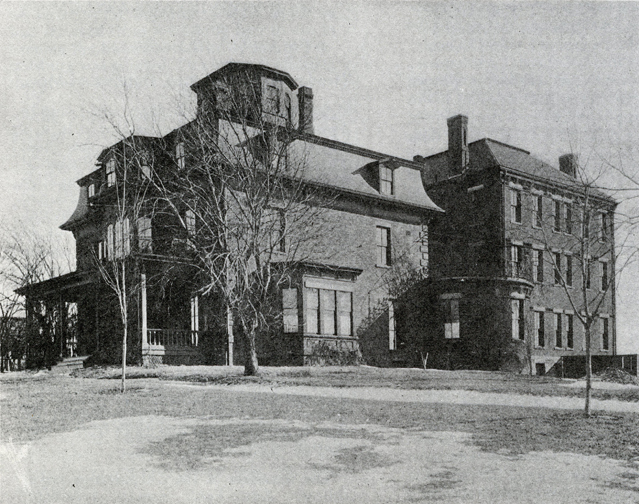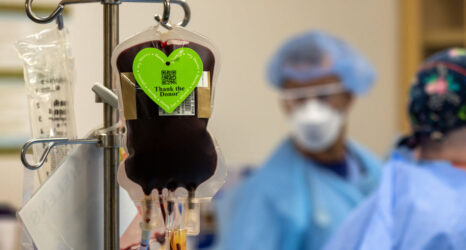Now that infant relinquishment may once again become the only legal solution to an unintended pregnancy, it’s essential to hear the voices of women who have lost children to adoption, a wound that never heals.
Our Abortion Stories chronicles readers’ experiences of abortion pre- and post-Roe. Abortions are sought by a wide range of people, for many different reasons. There is no single story. Telling stories of then and now shows how critical abortion has been and continues to be for women and girls. Share your abortion story by emailing myabortionstory@msmagazine.com, and sign our “We Have Had Abortions” petition.

Back in the fall of 1966, when I should have been starting my sophomore year at the University of Massachusetts in Amherst, my father drove me instead to a gloomy Georgian mansion in a northern neighborhood of Boston: St. Mary’s Infant Asylum. I’d be hidden there until I gave birth to a baby who’d immediately be given up to closed adoption. All documents related to that transaction would be sealed forever by the courts.
My pregnancy resulted from an impetuous relationship with a guy who was joining the Marines and hoping to see combat in Vietnam. It ended when I told him I was pregnant. He laughed and said the baby couldn’t possibly be his. We never spoke again.
This shameful secret—my pregnancy, the loss of my child—festered inside me for more than 50 years. I went on with my life, completed my education, married and had other children but I never escaped the winding cloths of shame and guilt that wrapped around me during my stay at St. Mary’s, and the surrender of my son. My parents never again acknowledged what had happened.
In the 2010s, Massachusetts—unbeknownst to birth parents—opened its adoption records to certain groups of adult adoptees. My middle-aged son paid $25 for a copy of his original birth certificate, then found me via a quick Google search. He reached out to me on email and we met—a longed-for experience that soon turned into a nightmare for me. The nightmare had nothing to do with my son, a well-raised man who had himself done two tours during the Gulf Wars. It had everything to do with me, and what had happened to me back then.
When my son connected with me, I had no idea reunion in adoption is often shattering—that it shoves an unprepared first mother (me) back into the skin of the terrified girl she’d been when she got pregnant, a girl without resources who paid dearly—and continued to pay—for her transgressions. The last time I’d seen my baby, he was sweet and warm and wrapped in soft swaddles. Then my caseworker took him from my arms and disappeared with him into a hospital elevator. Boom. Gone. Just like that. I had no hope of ever seeing him again.
I had no idea that reunion in adoption is often shattering—that it shoves an unprepared first mother (me) back into the skin of the terrified girl she’d been when she got pregnant.
Our reunion turned into a depth charge. The pain and anguish I wasn’t allowed to feel when I gave him away exploded inside me. Memories of my pregnancy and his birth, and of my relationships with my volatile and often violent parents, came back in vivid color—along with equally vivid memories of those turbulent times, the 60s! These memories brought me to my knees time and again.
While this agonized reckoning was going on inside me, Donald Trump was elected president, and a faith-driven authoritarian culture reemerged in government. Stripping women of their hard-won reproductive freedoms was a top agenda item for lawmakers in many states. In June, their ardent desires came to pass: A Supreme Court with three conservative religious justices appointed by Trump, overturned Roe v. Wade.
It took days for the wretched news to sink in. I burst into tears at the slightest provocation. I was weeping for all the young girls who could end up bearing children for the many infertile couples who want them. Girls, like me, on the cusp of adulthood. I have no doubt that this will happen.
Those who have grown up with reproductive choice, including my own daughters, don’t understand what it’s like to live in a world without it. Reproductive choice: the one thing I was certain my generation of feminists had given to the women coming up behind us. We failed to end wars or poverty; we didn’t end racial prejudice or gun violence, but we did win the right to choose if and when to become a mother. We had won for our gender essential control over our own fertility.
Many who grew up with access to contraception and legal abortion are ignorant of the post-war adoption boom when between 1.5 and 4 million American girls gave up their newborns to prosperous white couples. I have not forgotten, and I can tell you from that it is a life-long devastation, a loss that can never be healed. We were shamed into silence. We could not tell our stories. Our silence was surely a factor in this devastating loss of reproductive rights.
Back to St. Mary’s which shared its Boston campus with St. Margaret’s Lying in Hospital. When I showed there with my suitcase, my swelling belly and my anguish, I had no idea that thousands unmarried pregnant girls had already passed through its doors and left without their babies. I had no idea that, like them, I’d become a girl so changed by her experience of confinement and loss that I no longer recognized myself. That my life-long struggle would be to reconcile my grown up self with the artsy teenager (a poet and a dancer) I had been, a loveless girl disdained by her turbulent Scots Irish Catholic family and caught between the grinding plates of a changing culture.
When I showed there with my suitcase, my swelling belly and my anguish, I had no idea that thousands unmarried pregnant girls had already passed through its doors and left without their babies.
During my stay at St. Mary’s, I had no clue that it was just one of about 200 ‘homes’ for unwed mothers—a minority of them Catholic—operating at full capacity in 40 states. I had no idea that, the year my son was born, nearly 84,000 other unmarried American girls relinquished newborns to closed adoption. By 1970, according to the University of Oregon’s Adoption Research Project, that number increased to more than 170,000. Most like me were white and middle-class.
St. Mary’s Infant Asylum was run by the Daughters of Charity as part of the archdiocese of greater Boston. The nuns, still in traditional black habits and wimples, watched over us, monitoring our every move as we awaited the births of our ‘misbegotten’ children who would soon join the families of affluent couples.
Banished from our families and abandoned by the fathers of our babies, we wandered the dim hallways in homemade maternity smocks or clothes left behind by other girls, usually in slippers, often on swollen feet, our arms around our own big bellies, comforting ourselves and the babies we carried, knowing we could not keep them, but not knowing what that would mean.
We got our prenatal care and gave birth at St. Margaret’s. It was, at the time, considered one of the best maternity hospitals in the country. Rose Kennedy gave birth to Teddy there. Former Boston mayor and current Secretary of Labor Marty Walsh was born there, too, and the infamous Wahlberg brothers, Mark and Donnie. We girls from the ‘home’ were isolated in special rooms there—but not quite out of sight or ear shot of the happy married couples celebrating the births of their children.
For us, the doors to St. Margaret’s only went one way. Girls who left to give birth were not allowed to return to the home. No chance, that way, those new mothers could tell us what happened during childbirth or what it felt like when their baby disappeared.
Back then I believed—like most, or maybe all of us—that I was doing the right thing, signing away my parental rights. I believed that my baby would be better off without me. That is what the nuns and social workers and parents had drummed into us: We weren’t fit to become mothers.
A few decades later, with the widespread availability of contraception and safe legal abortion, along with a change in cultural attitudes, maternity homes began shutting down. In 1993, bulldozers rolled in to demolish the mansion housing St. Mary’s. It was erased from the ground it had stood on for well over a century. St. Margaret’s closed down, too, and moved its operations to the pavilion of another Boston hospital. After that, the hospital building was repurposed into St. Mary’s Center for Women and Children, an agency that claims on its website to support 600 young mothers and their babies every year with “shelter, clinical and educational services, job training, employment placement and the search for affordable permanent housing.”
This mission, a reversal of its prior activities, sounds as wonderful as it is essential. It’s just what I needed back when I was a forlorn pregnant teenager. I would have been able to keep and mother my son.
I believed that my baby would be better off without me. That is what the nuns and social workers and parents had drummed into us: We weren’t fit to become mothers.
On its website, St. Mary’s claims to be continuing “a rich history of caring for young mothers and their children” that was first established by the Daughters of Charity in 1870. While the physical location of St. Mary’s changed several times during that time, the website declares that its mission has stayed the same: “welcoming pregnant and parenting teen girls and their infants, and providing them with shelter, comfort and care.”
I did not receive any comfort while I was there, and the care was focused on my baby, not me. When I say this, I am bearing witness for the countless others who have been silenced. Then I noticed a half-century long gap on the timeline. Not a word about the work being done at St. Mary’s from 1943 to 1993. 50 years! No tally of how many babies were taken from their powerless young mothers and handed off to well-heeled couples. No tally of how many mothers and babies were, like me, devastated by the experience. Like the mansion in which we were hidden, we have been erased. This erasure seems intended to hide what was really going on inside those ancient walls. Secrets and silence, the formidable weapons of the powerful.
Now that infant relinquishment may once again become the only legal solution to an unintended pregnancy, it’s essential to hear the voices of women who have lost children to adoption, a wound that never heals.
I’m one of the lucky ones. I am reunited with my son and I’ve raised three other children. I’m grateful my son found me and for our relationship, but it has done nothing to ease the pain of my loss or my experience of shame and shunning at the hands of those far more powerful than me. For most of my adult life, I enjoyed the certainty that no other girls and women, including my own daughters, would ever be forced into childbearing for other parents. The brutal demise of Roe v. Wade has replaced that certainty with dread and the awful specter of the maternity home looms over the culture once again.
Sign and share Ms.’s relaunched “We Have Had Abortions” petition—whether you yourself have had an abortion, or simply stand in solidarity with those who have—to let the Supreme Court, Congress and the White House know: We will not give up the right to safe, legal, accessible abortion.
Up next:





